Yves Saint Laurent’s ‘decadent’ homes

“Down a shuttered Paris street, through a quiet courtyard, and doors open on to the place where Yves Saint Laurent lives.” So began an article in the May 1972 issue of British Vogue, which featured the duplex of Yves Saint Laurent and his partner, Pierre Bergé, at 55 Rue de Babylone, which they bought in 1970. The story conjured up a secret destination, an inner sanctum, accessible only to its owners and their glamorous entourage.
More like this:
– How our strangest dreams come to life
– The hidden meanings in wearing black
– Yves Saint Laurent’s ultimate obsession
Paradoxically, although their home was a retreat, Saint Laurent and Bergé were media-savvy image-makers. Its location on Paris’s relatively bohemian Left Bank had symbolic importance, signalling Saint Laurent’s progressive values. In 1966, he had launched his Rive Gauche ready-to-wear men and womenswear label and boutique on nearby Rue de Tournon, and had publicly declared that the hegemony of haute couture was “démodé“, although he continued to create couture collections.
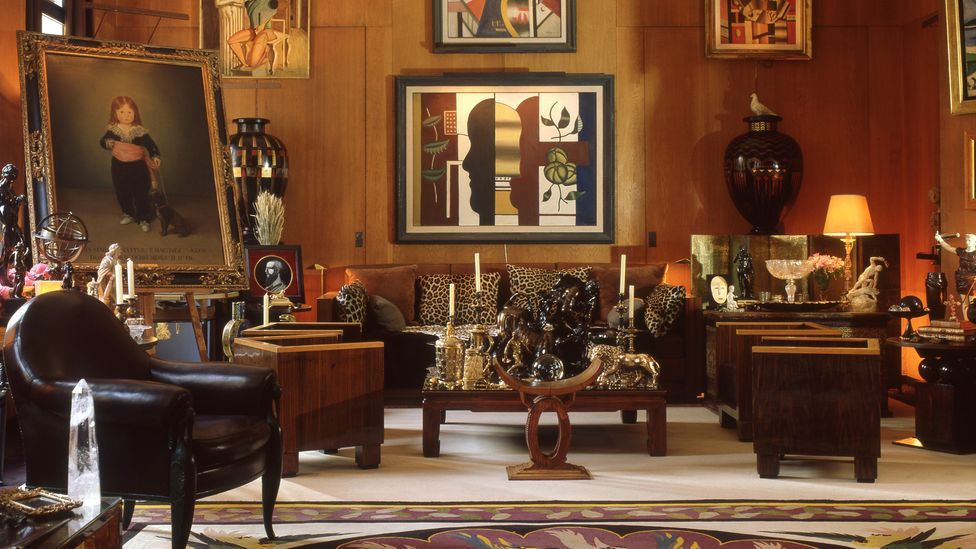
With its Art Deco wood panelling and eclectic mix of art, the Paris apartment made a statement about its owners, Yves Saint Laurent and Pierre Bergé (Credit: Marianne Haas)
The apartment’s interior was created in the Art Deco style by French architect Jean-Michel Frank in the 1920s, reflecting Saint Laurent’s obsession with the Jazz Age, which was also echoed in his ready-to-wear collections of the time. The designer was in thrall then to the streamlined yet luxurious aesthetic of high-end Art Deco, and the apartment housed Eileen Gray’s Dragon armchair, stools by Pierre Legrain, vases by Jean Dunand, Gustave Miklos’s stools with a red lacquer frame and opulent pieces bought at a 1972 sale of early 20th-Century couturier Jacques Doucet’s collection of modern art and furniture.
A new book, Yves Saint Laurent at Home – Life with Yves and Pierre, written by their friend, the interior designer Jacques Grange, showcases the couple’s 1970s homes. Their other key 70s residence was Dar es Saada, a pink mansion in a secluded spot in Marrakech, acquired in 1974, whose interiors were redesigned by Bill Willis. For Saint Laurent, who was born in French Algeria, their Moroccan villa – surrounded by the paradisiacal Jardin Majorelle created by French “Orientalist” painter Jacques Majorelle – offered an escape from the commercial pressures of Paris.
“As the first celebrities to allow their homes to be photographed for interior design magazines, Saint Laurent and Bergé practically transformed Marrakech into Paris’s 21st arrondissement,” writes journalist Laurence Benaïm in the book. The openly gay couple had holidayed in Marrakech in 1967, and mingled with bohemian Americans Talitha and Paul Getty. The young, epicene Saint Laurent grew his hair, adopted a more relaxed hippy look, and smoked kief (hashish, common in North Africa), with his friend and muse, Loulou de la Falaise. In the mid-1970s, he donned loose kaftans there and in 1976 designed a Moroccan-inspired, vibrantly coloured womenswear collection – simple tunics and harem pants in purples and oranges.
Better known as a fashion designer, Saint Laurent is nevertheless admired by many for his taste in interiors, says Martina Mondadori, editor of Cabana magazine and co-author of the book, YSL Lexicon: An ABC of the Fashion, Life and Inspirations of Yves Saint Laurent: “There isn’t a fashion designer or interior decorator in the past 15 years who hasn’t been inspired in some capacity by Saint Laurent’s vision. Dar Es Saada was an ode to the versatile, sophisticated world he lived in. The flow of rooms on the ground floor is the perfect set design for any party. It’s as decadent as it gets, and the velvets, the colours and tiles make the whole house feel very intimate – ultimately the secret to making everyone feel at home.”
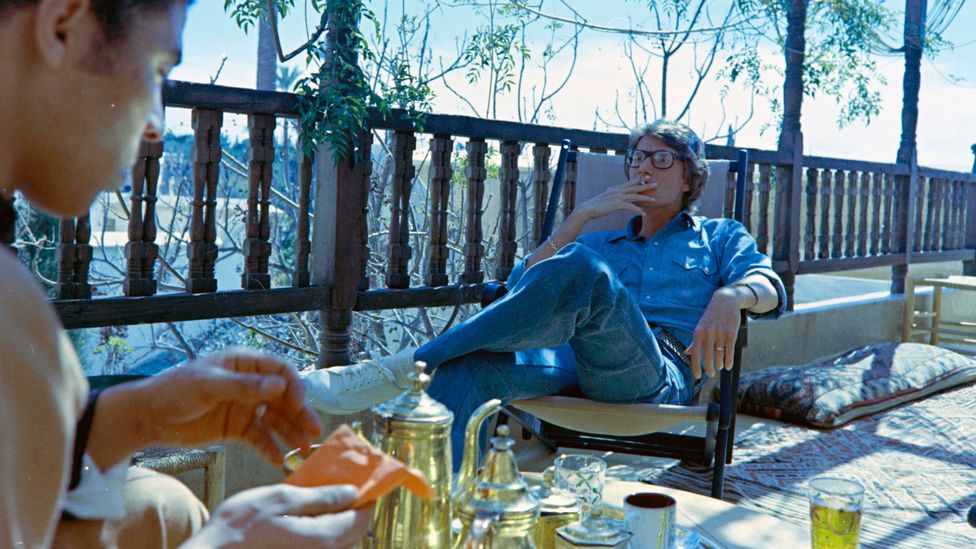
Saint Laurent on the terrace at the Marrakech home he shared with his partner (Credit: Getty Images)
But it was the couple’s elegant apartment at Rue de Babylone in Paris that was the epicentre of their social life and the perfectly curated setting for their lifestyle. “Saint Laurent and Bergé were ahead of their time,” says Anthony Barzilay Freund, editorial director and trends expert at 1stDibs, an online space for antique and contemporary design, art and fashion. “True collectors compelled by beauty and quality, they were extremely eclectic. What unified their collection was the excellence of every object. The rooms at 55 Rue de Babylone must have served as great settings for social gatherings. There must have been a sense of welcome and festivity expressed through the diversity of the décor, felt by guests.”
Boho-luxe furniture, redolent of Saint Laurent’s 1970s lifestyle, is currently in demand. Danish brand Gubi recently reproduced the Bohemian 72 collection of the late Milanese designer Gabriella Crespi in collaboration with her daughter Elisabetta Crespi, which includes rattan seating with plump cushions. “1970s furniture was characterised by an emphasis on cosiness and comfort – low-slung seating with soft, cloud-like cushioning – and by a leaning towards organic materials, evocative of the natural world,” says Marie Kristine Schmidt, chief brand officer at Gubi. “A legacy of a late-1960s bohemian sensibility, this rejected convention in favour of freedom and self-expression. It was designed for socialising and entertaining without fussiness or formality.”
Look back in languor
Each room of the boho-chic apartment had a distinctive mood: a vast wood-panelled 1920s salon, a white-walled, book-lined library, a rich red hallway, a mirrored den. Saint Laurent adored Chinese artefacts and Chinoiserie. This also found expression in his 1977 haute-couture collection with an “Imperial China” theme – lamé jackets with pagoda-inspired shoulders and lacquered red “coolie” hats – that presaged the launch of his perfume Opium. The scent’s ad campaign featured 70s supermodel Jerry Hall shot alongside white orchids in the apartment’s dark, atmospheric “Oriental Room”.
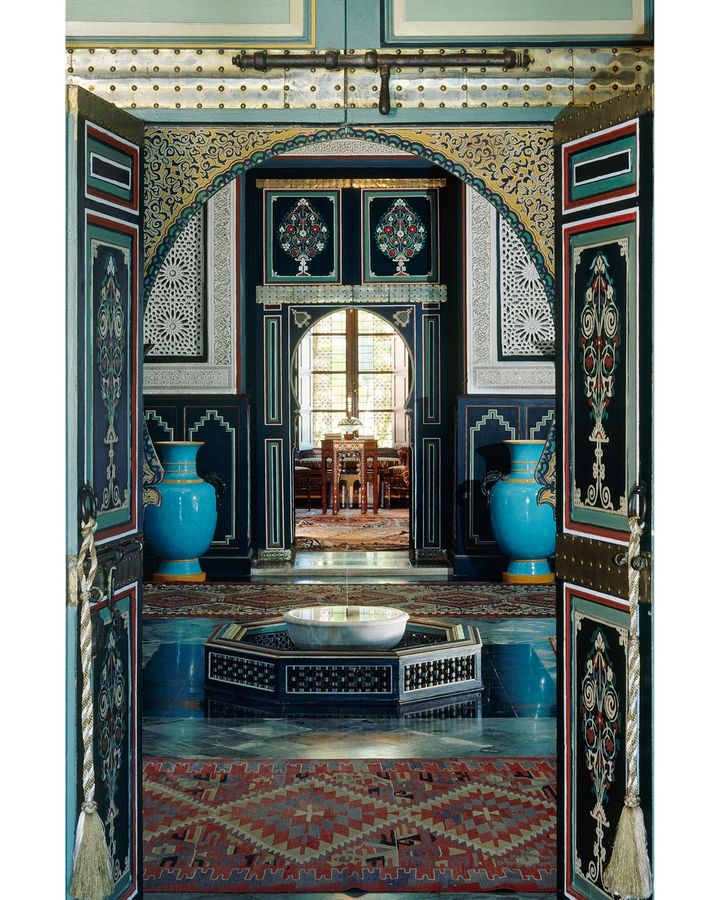
Along with the Paris apartment, the pair’s villa in Marrakech was also the scene of frequent parties and glamorous gatherings (Credit: Marianne Haas)
Vogue’s window on to this elegant universe was teasingly represented by Saint Laurent and his other main muse Betty Catroux striking conspiratorial poses. The two were snapped in his all-white library-cum-studio clasping hands, laughing uproariously and sprawling elegantly on a dazzling white sofa, she in a cardigan “silvered with sequins”, pussybow “mousseline blouse” and “black dinner trousers”, he in a spotless white suit and lace-ups, taffeta shirt and silk bowtie.
The room boasted a Lalique balustrade and surreo-pop pieces by contemporary French sculptor Francois-Xavier Lalanne, from a futuristic, steel, egg-shaped bar to sheep-shaped stools. Another showed the pair reclining among brocade floor cushions in the dimly lit Oriental Room, she with cigarette holder in hand, he in a black satin jacket and gabardine trousers. Behind them a gilded Ming Dynasty Buddha glows against mirrored walls illuminated by candles.
Saint Laurent and Bergé enhanced the exoticism of 55 Rue de Babylone by creating a multisensory setting. “It was one of the sexiest places I’ve ever been in,” recalls writer Marian McEvoy about the apartment in the book, The Beautiful Fall – Fashion, Genius and Glorious Excess in 1970s Paris by Alicia Drake. “The surfaces were tactile, the colours almost edible and the lighting so flattering. There wasn’t one lamp that if you walked by you didn’t feel absolutely beautiful in its light. The fires were always at the right point, there weren’t too many logs or too few. It was an overwhelmingly sensual interior.” As Drake puts it: “Every room smelt of lilies and ivy.”
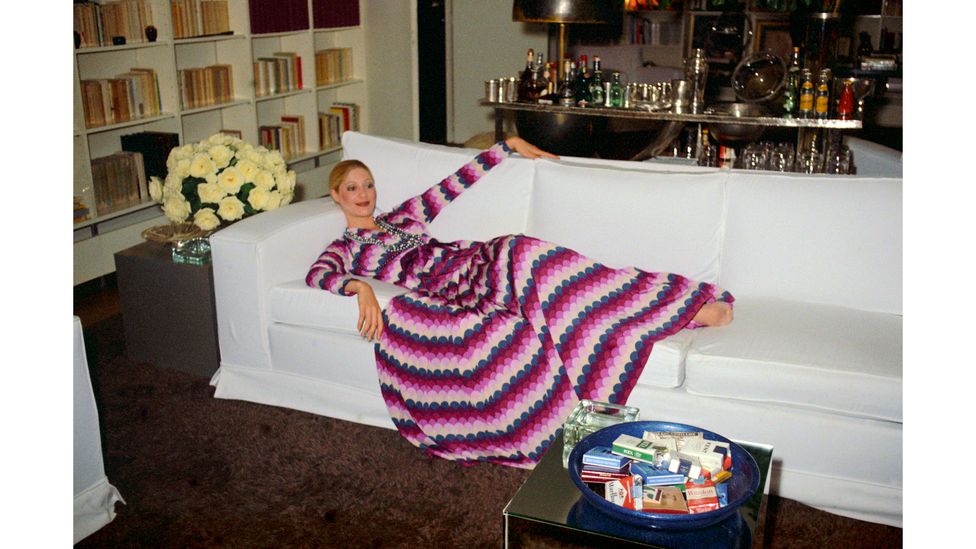
The Paris apartment was a gathering place for the couple’s glamorous social circle (Credit: Getty Images)
Saint Laurent’s coterie also included the glamorous Loulou and aristocratic Thadée Klossowski, son of the painter Balthus – whom she married in the 70s – Paloma Picasso, who wore eccentrically retro 1940s clothing, and the dandyish Jacques de Bascher, briefly Saint Laurent’s lover.
What set 55 Rue de Babylone apart from stylish interiors of the day was its eclecticism. Saint Laurent and Bergé were by no means alone in collecting Art Deco design – many others were swept up in what was a global craze. But, as Benaïm notes in the book, “While France thought of itself as ultra-contemporary, in shades of white and orange, Saint Laurent and Bergé sidestepped the diktats of their peers to rekindle the decorative arts of the 1920s and 30s”.
Pieces from all periods formed part of this complex mix: a homoerotic ancient Greek marble male torso, a 19th-Century sculpture of a bird from the Ivory Coast, a sculpture by Constantin Brancusi, a monumental tapestry by pre-Raphaelite Edward Burne-Jones and paintings by Goya, French Romantic Theodore Géricault, Surrealist Giorgio de Chirico and Cubist canvases by Picasso and Léger. Alongside these were a few contemporary pieces, including multicoloured Warhol portraits of Saint Laurent, painted in 1972.
Enduring influence
One current interior inspired by 55 Rue de Babylone is a duplex in Paris’s well-heeled Trocadéro area, revamped by Parisian interior design studio Hauvette & Madani, fans of the heady Saint Laurent-Bergé lifestyle. The practice has even designed a furniture collection inspired by their clique – including a silk, Chinese-inspired pendant lamp called Betty and a maplewood bedside table named Yves.
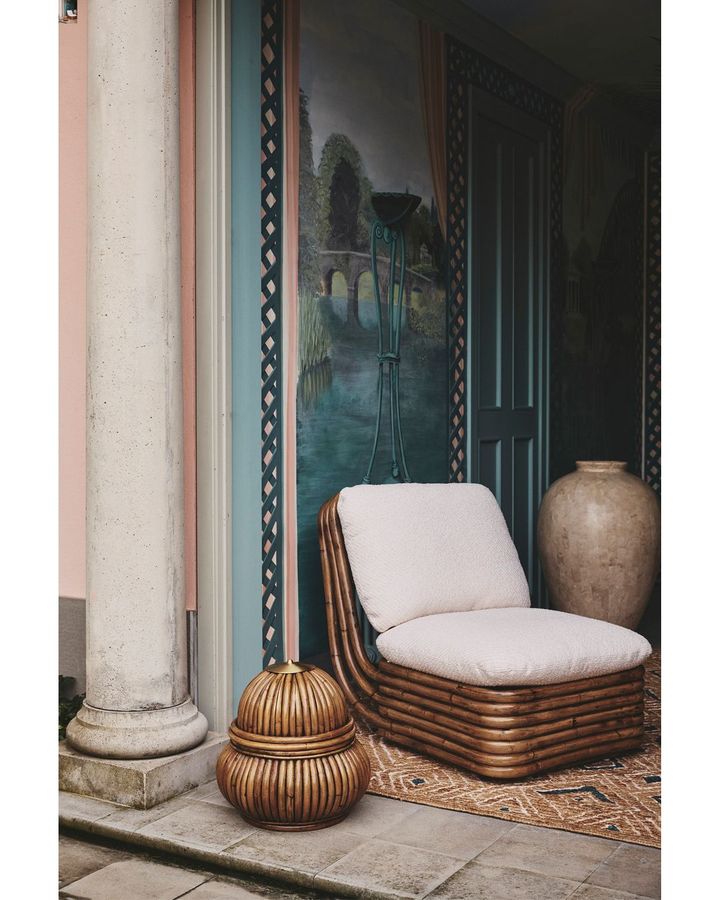
Contemporary Danish brand Gubi’s low-slung seating echoes Saint Laurent and Bergé’s 1970s boho-luxe style (Credit: Gubi)
Occupying a 1980s building with an Art Deco-inspired interior, the duplex has oak-panelled walls. “When you walk into a wood-clad room it has a special sound and smell,” says the studio’s co-founder Samantha Hauvette, adding that the duplex instantly evoked the hedonistic soirées thrown by Saint Laurent and Bergé; the studio pays homage to this by hanging photographs of these events on a mezzanine level.
“We like mixing different pieces,” she continues. “Saint Laurent and Bergé took a very personal approach, collecting individual items that caught their eye, then figuring out how to combine them when they got home. We love how their homes were designed around entertaining, with parties revolving around the Parisian tradition of apéro – short for apéritifs at home, usually champagne, red wine or rosé – and the contrast of these well-dressed beautiful people in such elegant surroundings drinking. I can’t imagine them ever sitting down to dinner in the dining room; they’d head out instead to cool clubs of the time like Club Sept and Le Palace.”
“Saint Laurent and Bergé’s style appeals because their collecting was driven primarily by passion and spontaneity,” says Gergei Erdei, a homeware designer whose pieces have a 70s Saint Laurent vibe. One inspiration for him is Rue de Babylone’s wood-lined living room: “This is so different to celebrity homes you see in magazines today, often decorated with a bland total look.”
Yet it would be simplistic to suggest that Saint Laurent’s approach was purely for fun. With its rare, sought-after art and antiques, 55 Rue de Babylone was also a statement that he’d arrived. “The move marked a new phase in his life,” observed Drake. “He and Pierre were flush with money and spending in considerable style. They were building the image of the house of Saint Laurent on the cult of the man and the new home was in perfect accord with this cult and with Yves’s social status of couturier.”
“Saint Laurent was one of the most famous creative people of his generation and his apartment was staged to attract attention,” says Erdei. “It’s telling that he and Bergé’s bedroom, their most private space, was relatively pared-down.”
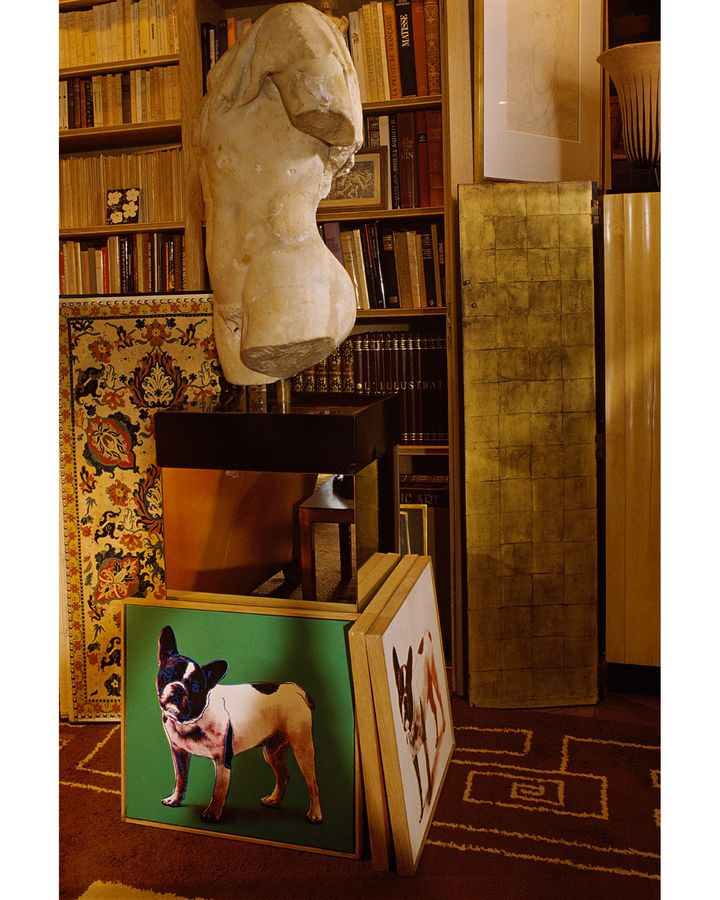
Saint Laurent and Bergé’s apartment at 55 Rue de Babylone had an intimate, bohemian feel that still resonates today (Credit: Marianne Haas)
Mondadori says that Saint Laurent’s talent lay in a pluralist yet personal creative approach: “He sat in his studio or at home and would dive into a distant country and cultures by immersing himself in books, movies and so on. He wasn’t didactic but preferred to mix different influences – make the elements his, before turning them into an idea for an interior or collection.”
Perhaps the enduring interest in the Saint Laurent aesthetic lies in its wide-ranging eclecticism that can’t be pinned down, chewed up and discarded. “The impact of ‘le style YSL’ cannot be dissociated from the man, his clothes and brand,” says interior designer Fabrice Bana, one of whose projects includes high-gloss lacquered, dark purple walls – a nod to the Music Room at Rue de Babylone. “His interiors are intricately part of the YSL DNA which was globe-trotting, era-defying, carefully curated.”
Yves Saint Laurent at Home: Life with Yves and Pierre by Jacques Grange with photos by Marianne Haas is published by Assouline.
If you would like to comment on this story or anything else you have seen on BBC Culture, head over to our Facebook page or message us on Twitter.
And if you liked this story, sign up for the weekly bbc.com features newsletter, called The Essential List. A handpicked selection of stories from BBC Future, Culture, Worklife and Travel, delivered to your inbox every Friday.








